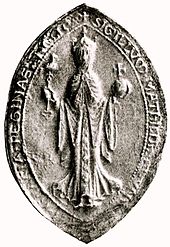Matilda of Tuscany had become a
powerful woman with a great deal of influence in northern Italy. She had a big concern, however: she was the last of the House of Canossa, and there was no one to whom to leave her position and possessions. She needed an heir. A daughter born of her first marriage to Godfrey the Hunchback, Beatrice, died within a few weeks. She also wanted allies in her ongoing hostility with Hole Roman Emperor Henry IV, and political marriages were a traditional way to make allies.
In 1089, she married Welf (the illustration is their marriage from a 14th century history by Giovanni Villani), who in 1101 would become Duke of Bavaria. Matilda was in her 40s by now, and Welf was a teenager. Cosmas of Prague in his Chronicle of Bohemians records a letter from Matilda to Welf:
Not for feminine lightness or recklessness, but for the good of all my kingdom, I send you this letter: agreeing to it, you take with it myself and the rule over the whole of Lombardy. I'll give you so many cities, so many castles and noble palaces, so much gold and silver, that you will have a famous name, if you endear yourself to me; do not reproof me for boldness because I first address you with the proposal. It's reason for both male and female to desire a legitimate union, and it makes no difference whether the man or the woman broaches the first line of love, sofar as an indissoluble marriage is sought. Goodbye.
This "letter" is now considered fictional, but it is a clue from a contemporary historian regarding what he thought the motivations would be for the teen to marry Matilda. There were 120 days of wedding festivities. Cosmas also suggests that Welf was reluctant to act the proper husband; whatever the reason, the two separated by the spring of 1095. There was no annulment or divorce, but the two were no longer together. Matilda had another idea for an heir, however.
Around 1099, she turned to her allies in Florence, the Guidi Family, adopting one member of the family, Guido Guerra. He appears in records as adoptivus filius domine comitisse Matilde ("her adoptive son accompanied count Matilda"). Unfortunately for Guido, she donated all her possessions to the Apostolic See at Canossa in 1102. Guido, realizing he had nothing to inherit, left her side. If she had not adopted Guido or made the donation, Welf would have inherited, since there is no record of the marriage being dissolved. She cut them both out of the picture with what is called the Matildine Donation.
That seems to be another story, however. Scholars now believe the Matildine Donation is a faked document from the 1130s, long after her death. The pope did not want Canossa's ownership to go outside of Italy to Bavaria, which it would have done because of the marriage to Welf. So the Church faked the Donation.
In reality, references to the Matildine Donation are only found in religious documents, not in any other secular collection of records. In her later years, Matilda had better relations with Henry IV's heir, Henry V. In May of 1111, Henry V visited her, and from that visit apparently came an inheritance agreement that Henry V would be her heir and all hostilities and penalties that had been imposed upon her by her opposition to Henry IV would be dropped.
Matilda's life became quieter in her final years. Donizo of Canossa, a monk, wrote a history of the House of Canossa, part of it especially focusing on Matilda. She continued to promote the arts and literature, especially religious literature. One work dedicated to her was the Orationes sive meditationes ("Prayers and Meditations") by Anselm of Canterbury.
She died on 24 July 1115, but her prominence in life led to legendary status in death. She became known (erroneously) as the sole benefactor of several churches and monasteries in northern Italy. She can be seen at night at the Savignano Castle, riding a white horse during the full moon. A fountain she asked the pope to bless can get a woman pregnant with a single drink from it. Scholars looking at the Investiture Controversy give her plenty of attention.
Anselm of Canterbury (also known as Anselm of Bec), who dedicated a work to her, was not an ordinary figure. Despite being Italian by birth, he rose to the highest clerical position in England, Archbishop of Canterbury. He also wrote what was probably the most significant work of theology in the history of Roman Catholicism. Let's look at him tomorrow.


















